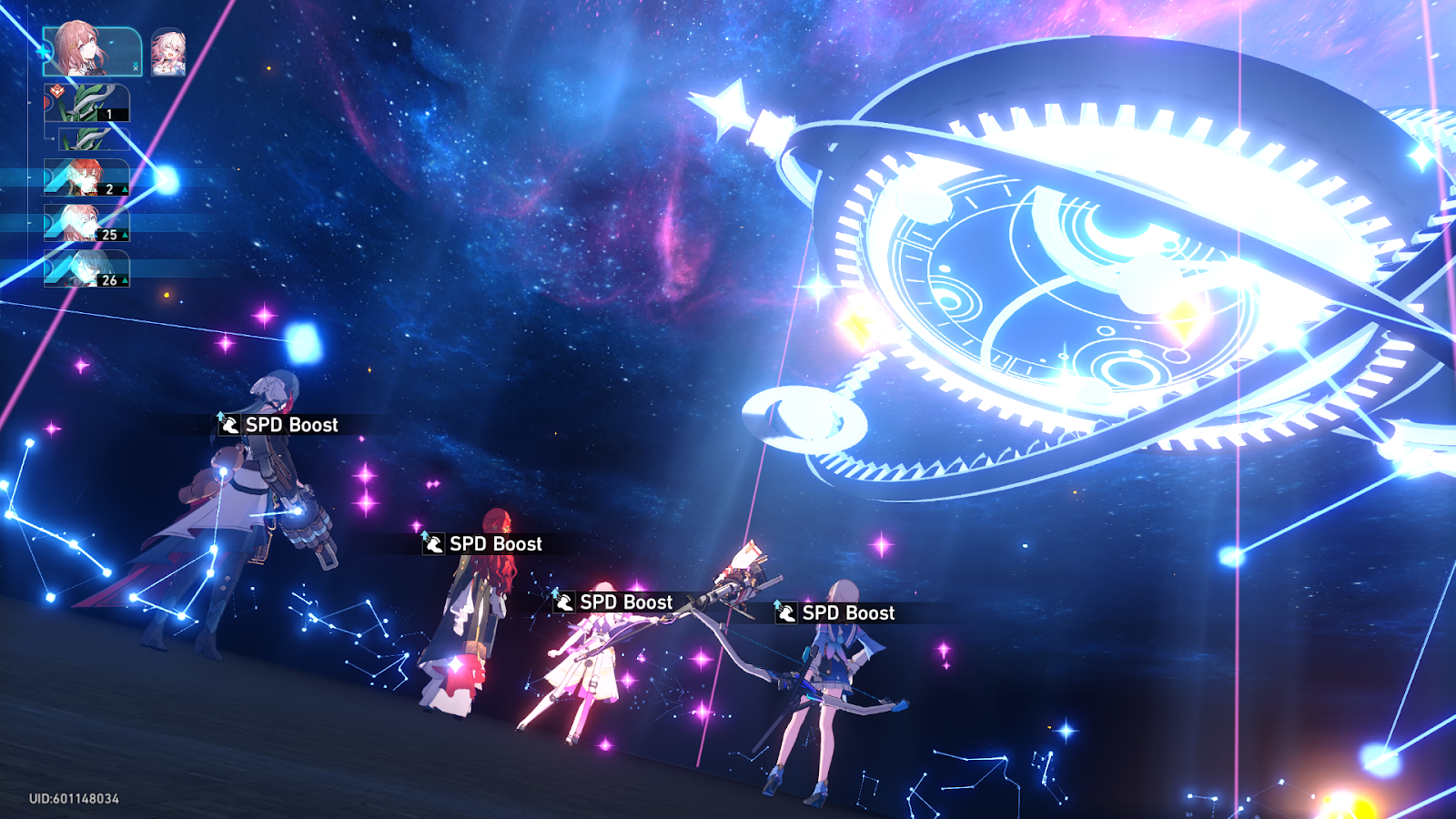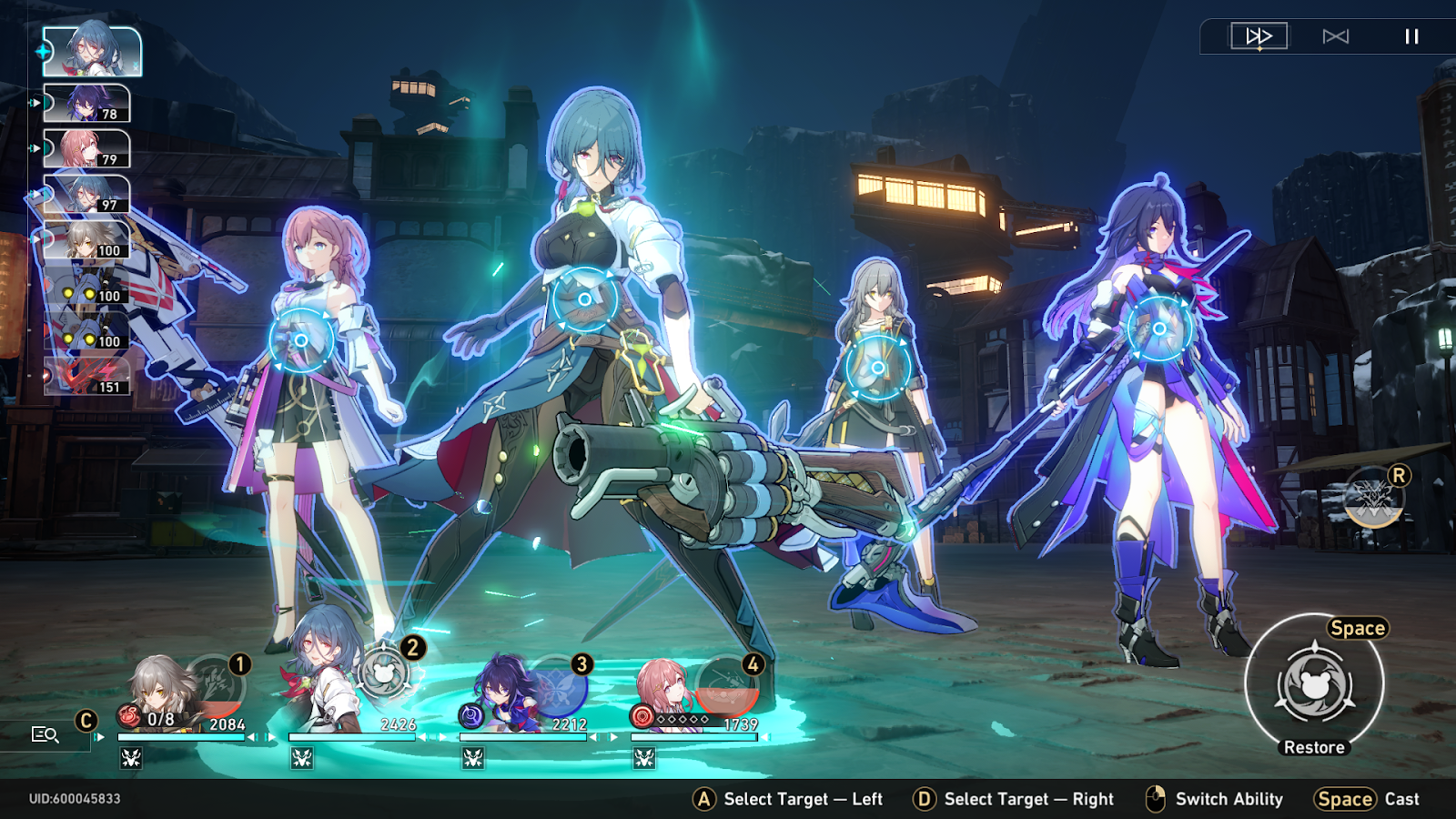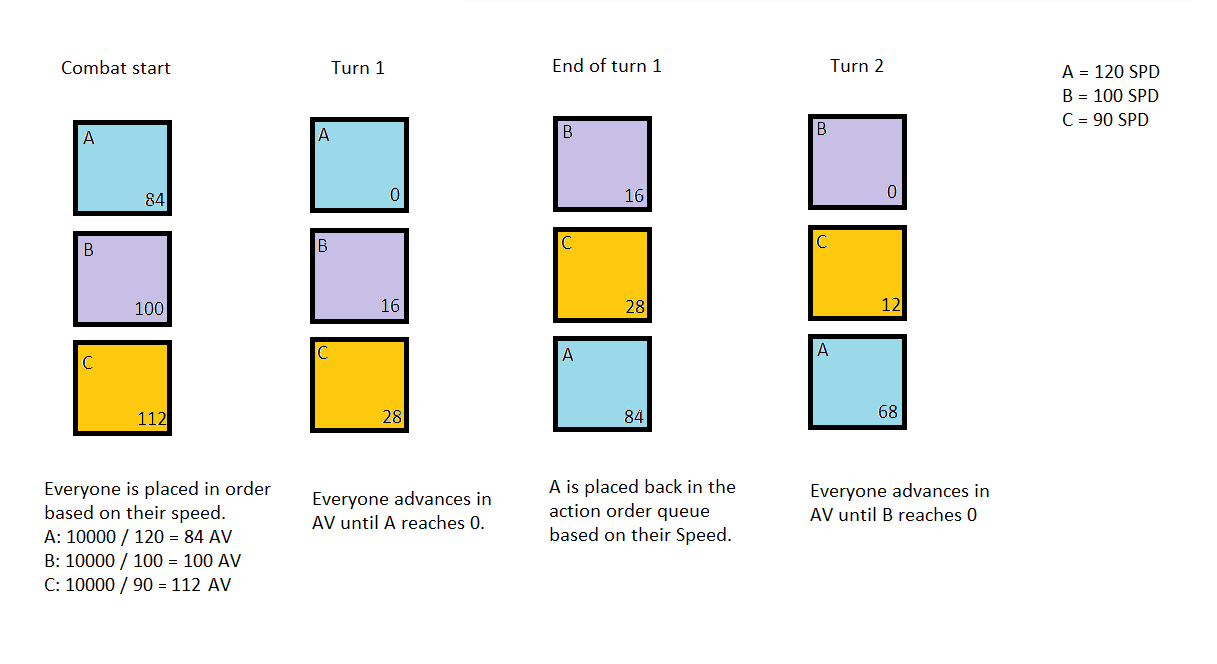A detailed overview of HSR’s most obtuse game mechanic.

Are you confused by how Speed works in Honkai: Star Rail? You aren’t alone. It’s not explained anywhere in-game, despite the fact that it’s arguably the single most important stat in combat. This guide will teach you what Speed is, how it works, when it’s worth building, and who it impacts the most.
Table of Contents
The Basics of Speed and Turn Order
At first glance, Speed sounds pretty simple: the higher a character’s Speed, the more often they can act. A character with twice the Speed of another character will take twice as many turns.
The game determines turn order based on “Action Value” (AV), a stat which can be viewed on the left side of the combat screen. The lower a unit’s AV, the sooner they can act. The higher a unit’s Speed, the lower their Base AV (and, by proxy, the more often they can act). Whenever a unit completes their action their AV resets to their Base AV amount. The game then decreases all units’ AV equally until a unit reaches 0 AV, at which point it is their turn.
Action Value isn’t a number players can see by default. In the Other Settings under Settings, players can choose “Whether to display the character’s action value during a battle.” Enabling this feature in the settings will show the Action Value next to each character and enemy in the Action Order.

So, in short: higher Speed means lower Base AV. Lower Base AV means lower downtime between turns. Lower downtime between turns means taking more turns.
How AV and Base AV are calculated and the ways you can modify AV (e.g., Action Delay, Advance Forward, and Speed manipulation) are covered in the section “How Does Speed Really Work.“

The numbers to the right of each character portrait in the top left are each character’s current AV. They are invisible by default; to view them, you must enable them in Other Settings in the Settings Menu.

After the current combatant finishes their turn, their AV is reset to their Base AV. The game then advances all combatant’s AVs equally until another combatant can act.
So, When Is Speed Worth It?
There are a lot of advantages that make Speed valuable for most characters. One of the biggest reasons is that some Planar Ornament Sets have passives which are locked behind certain Speed thresholds – most notably Fleet of the Ageless and Space Sealing Station. In particular, Fleet of the Ageless is such a powerful effect that most characters want 120 Speed for it alone. Additionally, extra actions don’t just bring extra damage and healing – they improve your ability to Break enemies, apply DoT effects, and trigger other useful passives.
So then Speed is always worth it, right?
Wrong! There are a few caveats that can make Speed an awkward choice. Most of them relate to the opportunity cost involved in investing in Speed over other combat stats, though a few are tied to specific character interactions.
The first reason why Speed may not be worth it is fairly straightforward – by investing in Speed over ATK%, CRIT, or other valuable damage stats, you lose some of your ability to frontload damage. While Speed can generate more actions, you aren’t getting those actions until your additional Speed would be enough to overtake an enemy’s AV. So if everything’s dead before that, well… all it did for you was bump you up in the Action Order. For example, 5★ Speed Boots offer about 25 Speed; for most characters, this gives you one extra turn per four turns taken. Depending on when a battle ends (i.e., Cycle 3, Cycle 7, Cycle 11, etc.), these ~125 Speed characters might not get the full value of their Boots, and may actually have preferred building stats like CRIT and ATK% instead.
Second, the additional utility and flexibility that comes with the extra turns from high Speed can be difficult to exploit. In order to capitalize on your extra turns, you have to allocate Skill Points and align buffs ahead of time. Generally speaking, each new turn is a chance to use a Skill or gain a Skill Point. Mismanaging these opportunities can make Speed worse than other offensive stats like ATK%.
Finally, characters’ roles can impact how much they value Speed. Teams generally want their supports to be faster than their damage dealers in order to guarantee that buffs are applied before damage dealers attack.
Likewise, some characters don’t particularly rely on taking turns to deal damage. The 5★ Speed Boots from our example above are usually worse than the 5★ ATK% Boots on Clara and Himeko, because a portion of their damage comes from follow-up attacks that trigger regardless of turn order.
All of this is to say that Speed is an incredibly powerful utility stat, but it can be inconsistent based on a multitude of factors including overall difficulty, team composition, character playstyle, and enemy RNG. It’s rarely bad to get free Speed, but investing into it over other stats can represent a real drawback depending on the character in question.
Need For Speed
This section will examine the characters who benefit the most (and least) from Speed. It’s important to remember that wanting Speed isn’t always a black-or-white choice – there are characters who can like or dislike Speed depending on the situation, as well as characters who don’t build Speed, but appreciate it when it’s granted for free. Also note that this is not a comprehensive review of every character in the game. Upcoming character analyses will review Speed requirements in better detail, and cover characters not mentioned in this list.
The list is organized into three categories: characters that want more than, exactly, or less than 120 Speed. The idea behind this is that two of the best Ornament sets as of launch have 120 Speed thresholds for their passives – most characters want at least 120 Speed as a result.
Speed investment and optimization is a complicated topic. You may have heard of players in the space advocating for certain Speed breakpoints, including 134 Speed for two turns in one cycle in Memory of Chaos, 121 Speed for two cycling in Memory of Chaos, or other breakpoints. Evaluating Speed breakpoints requires that you compare the bonuses that you would gain from Speed from Planetary Ornament Sets, during Memory of Chaos cycles and enemies, and the stats that you could have on your character if you hadn’t invested heavily into Speed.
For example, pushing for 134 Speed so that you can gain two turns within the first Cycle of Memory Chaos is extremely valuable if you can clear the first wave immediately, but this boon is not relevant for players who are sacrificing other offensive stats to the extent that they cannot clear the wave anymore. These Speed thresholds continuously change depending on content for maximum optimization. The best thing KQM can really say at this point in time with confidence is that these breakpoints are yet to be determined necessary or truly optimal, and where they are best utilized. It is safe to say however, to keep Relics that have Speed substat rolls on them in the meanwhile.
120 Speed however, is a fairly safe investment for certain characters. Activating Planetary Ornament Sets can be trivial with just Speed boots to activate potent passives from Fleet of the Ageless, Space Sealing Station, or Sprightly Vonwacq.
Characters Who May Want More Than 120 SPD
Bronya (Fast) | If you can get ~150 Speed with a 4pc Eagle of Twilight Line Relic set, Bronya can take two turns before an enemy acts. This allows her to use her Basic Attack and then closely follow that up with her Skill to have a teammate Advance Forward. The benefit to this setup is that it effectively offsets her otherwise large SP cost, and takes advantage of her 100% CRIT Rate Basic Attacks. |
Pela | High Speed together with Energy Regen allows Pela to maintain uptime on her Ultimate in order to debuff enemy defense. |
 Welt | Welt, like Pela, prefers Speed because it allows him to apply his Speed debuff to enemies before enemy actions. Speed in combination with Energy Regen will also allow him to use his Ultimate every 2 enemy turns, to maintain the uptime on his Vulnerability |
 Sampo | The majority of Sampo’s damage comes from his DoTs, which only scale with ATK% and DMG%. Because of this, CRIT Rate and CRIT DMG are very low value. Instead, focus on Speed, ATK%, Energy Regen, and Effect Hit Rate%. Reaching 120 SPD is critically important for Sampo to get access to Space Sealing Station set bonuses, and he likes any extra Speed he can get to sustain his Wind Shear stacks. However, ATK% is ultimately the more important stat above that threshold. |
 Qingque (Normal Attacks only) | If you’re just Basic Attacking constantly and hoping to never touch your Skill, there’s really no reason not to go as fast as possible. More Speed means more Energy, which means more Ultimates. More Speed also means more Skill Points for your team. |
Bailu | Bailu is a bit weird in that she likes going fast but also dislikes her teammates going fast. The faster Bailu goes, the more SP she generates for the team. However, the faster her teammates are, the lower her Invigoration uptime (and thus total healing output) is. |
Characters Who May Want Around 120 SPD
Seele | Seele has an abnormally high base Speed of 115, which is high enough to hit 120 with very few substats. Additionally, because her extra turn triggers on kill, she actively wants to frontload her damage to make sure that each attack hits as hard as possible. Without her Signature Light Cone, she only needs enough Speed to trigger Ornament Set Bonuses. |
Asta | Asta’s ATK% buff is reduced heavily every turn, so the faster she acts, the more rapidly that buff will decay. However, she is the premiere Speed buffer, so you really can’t escape the Speed. Her buff provides enough Speed that building Speed above 120 on Relics is not worth it. |
Serval | Serval wants some Speed to maintain good Shock uptime; however, she also wants ATK% and CRIT as the rest of her damage is still dependent on them. Luckily, Serval has a fairly high base Speed for an Erudition character, meaning you can reach the 120 threshold with just Speed substats. This allows you to build ATK% boots and CRIT Rate% body while still getting the bonus from Space Sealing Station Ornament Set. |
 Hook | Hook’s painful base Speed is pretty problematic, and it’s only made worse by how much Hook benefits from being able to follow-up on her Burn status effect. Without significant Speed help, Hook can struggle to utilize her Ultimate and Talent. |
Characters Who May Want Less Than 120 SPD
 Clara | Going faster shortens Clara’s Ultimate’s uptime, which lowers the number of counterattacks she can output. Furthermore, the fact that most of her damage is tied to follow-up attacks means that she benefits much more from offensive substats like ATK% and CRIT. |
 Qingque (UsingSkills) | The more that Qingque’s allies act, the more likely it is that RNG blesses you with a Talent proc. The faster allies are relative to Qingque, the better your odds become. She also tends to use a lot of SP, so going too fast can leave you starved for SP. |
 Arlan | Arlan’s Skill consumes 15% of his Max HP whenever you use it, and is where his damage comes from. The faster Arlan is, the faster he spends his HP, which can be bad unless his healer has the same Speed. As a result, making Arlan hit harder is more valuable than making him faster. |
 Herta & Himeko | CRIT-based Erudition characters need a lot of offensive stats, have a high Base ATK, and have a lower base Speed compared to other Paths. All of this incentivizes them to go ATK% boots over Speed boots for better damage. Follow-up attacks are also not affected by Speed, further disincentivizing Speed stacking. A few Speed substats are fine, but sacrificing ATK% and CRIT for them is not recommended. |
 Bronya (Slow) | If you can’t build a ton of Speed, Bronya may go before allies by using Basic Attacks due to her Advance Forward Passive. It’s better to have all of the speed or none of the speed. |
How Does Speed Really Work?
This section is for readers who want a detailed, in-depth look into how Speed works in Honkai: Star Rail as well as its more esoteric applications and interactions. The section contains math and some equations, which is also directly accessible in the Formula Compendium below.
Action Gauge, Action Gauge Modifiers, and Other Invisible Stats
Action Gauge
Action Gauge isn’t something players can see; however, it is crucial to understand how AV is calculated and how Speed, Advance Forward, and Action Delay relate to the final displayed value in the Action Order. The Action Gauge is a hidden meter the game uses to calculate how far away a character is from acting. This Gauge has an initial value of 10,000 which decreases until it hits 0.
Let’s deconstruct a combat scenario to show how Speed works. During combat, everyone starts at 10,000 Action Gauge (AG). The game divides AG by Speed to find each character’s Action Value (AV), and then they are arranged from lowest to highest AV in order to determine the Action Order. In the case of decimal answers, the displayed AV is rounded up, regardless of how small of a decimal it is.
For every 1 AV that passes, a character’s current Speed is subtracted from their Action Gauge. If a character’s AV has not reached 0, this process will repeat constantly until someone can act. After acting, their AG goes back to its initial value of 10,000 and they are placed back in the Action Order accordingly.
An illustration of real time AV consumption is shown here:

The Action Gauge of any unit can be determined in real time by:
Current Action Gauge = Current AV * Current SPD
Action Gauge Modifiers
AG Modifiers, such as Advance and Delay, are effects that subtract or add fixed amounts to the Action Gauge. 1% of AG Modify is equal to 100 Units of Action Gauge. Since the Action Gauge needs to reach 0 before a character can act, a 1% Advance Forward will decrease the Action Gauge by 100 and a 1% Action Delay will increase the Action Gauge by 100.
However, a character can not be Advanced further if their Action Gauge is at 0. AG Modifiers also only affect the turn they are applied on and do not affect the Action Gauge of future turns.
The effects of Action Gauge Modifiers are described in this formula:
New Action Gauge = max(0 , Current Action Gauge – 10000 * (Advance Forward% – Action Delay%))
100% Advance Forward
When a character’s action is Advanced by 100%, their AV is immediately set to 0 and they will act as soon as possible, after any queued Ultimates and Passives. Since only their AV is set to 0, when they act, no other character’s Action Value is decreased until after they finish their turn. In the event of consecutive 100% Advance Forwards, the last character to be Advanced will act first.
Speed Buffs and Debuffs
Speed buffs and debuffs directly affect the Speed stat of a character and determine how often a character can act. If a character has a high Speed stat, they will act more often, if a character has a low Speed stat, they will act less often. Because the Action Gauge is decreased by your current Speed for every 1 AV that passes, Speed buffs and debuffs will increase and decrease your Action Value by a larger value when your current Action Gauge is high, and vice versa.
When taking into account Speed, Action Value and Action Gauge, we can determine the initial order of every character and enemy without any external effects through the calculation:
Base AV = Default AG / Speed , Default AG = 10000
The equation to calculate your new Action Value under effects of Speed buffs and debuffs without AG modifiers is:
New AV = Current AV * Current SPD / New SPD
Combining this with Action Gauge modifier formula, we get a general Action Value equation under any Speed and Action Gauge modifiers:
New AV = Current AV * Current SPD / New SPD – 10,000 * (Advance Forward – Action Delay) / New SPD
Speed Application
As stated above, Speed value depends on how fast it can translate into impactful and practical discrete extra actions a character can take. There is no absolute rule about how many extra actions Speed should convert into for it to be worth it compared to the more traditional offensive stats, and the choice between more or less Speed should be made depending on characters and teams. Generally, a good practice is making the most efficient Speed investments possible for it to convert into discrete actions that are foreseeable in around 4 turns, allowing one to make good short-term planning.
The equation to visualize how many actions Speed actually gives is:
Extra Action / Action Taken = New SPD / Current SPD – 1
Example: A 125 SPD character would act: 125/100 – 1 = 0.25 extra action for every action taken by a 100 SPD character, and they would act 5 times instead of 4 for the same AV taken.
Ultimates
Ultimates are special abilities which can be used any time, ignoring the current Action Order. A character’s turn only ends once AV is subtracted, so to keep buffs active, players can take their normal action and then quickly Ultimate on the same character to retain buffs from that turn. Additionally, Ultimates can be used immediately upon initiating combat, before any AV has been subtracted. This can reveal every character’s base AV upon starting combat and allow players to act before enemies quickly if they are slower.
In-Combat Action Gauge Modifier
Toughness Break
When breaking an enemy’s Toughness Meter, the broken enemy receives a 25% Action Delay to their upcoming action, thus adding 2,500 to their current Action Gauge. This value is not affected by Break Effect%.
Certain elemental Toughness Break effects have additional Action Gauge modifiers.
Imprisonment – Imaginary
When triggering a Toughness Break with an Imaginary character, enemies become Imprisoned. Imprison applies a 10% Speed Debuff as well as a 30% Action Delay. This Action Delay is affected by Break Effect% but the Speed Debuff is not.
The Action Delay value is described in the equation:
Final Action Delay % = 30% * (1 + Break Effect %)
Entanglement – Quantum
When triggering a Toughness Break with a Quantum character, enemies become Entangled. Entanglement applies a 20% Action Delay as well as a stacking Damage over Time (DoT), triggering upon the enemy’s next turn. This Action Delay and DoT damage are affected by Break Effect%.
The Action Delay value is described in the equation:
Final Action Delay % = 20% * (1 + Break Effect %)
Frozen – Ice
When triggering Toughness Break with Ice, enemies become Frozen. When a Frozen enemy reaches its turn and unfreezes, it takes one instance of Ice DoT, is unable to act for that turn, and receives a 50% Advance Forward on its next turn. Only the DoT is affected by Break Effect%.
Ambushes
In the event of an ambush, all characters are pushed back 20 AV in the Action Order, regardless of Speed or any other AG Modifiers.
Formula Compendium
Current Action Gauge:
Current Action Gauge = Current AV * Current SPD
Action Gauge Modifier:
New Action Gauge = max(0 , Current Action Gauge – 10000 * (Advance Forward% – Action Delay%))
Base Action Value:
Base AV = Default AG / Speed , Default AG = 10000
Final Action Value after Speed status effects:
New AV = Current AV * Current SPD / New SPD
General Action Value:
New AV = Current AV * Current SPD / New SPD – 10,000 *(Advance Forward%- Action Delay%) / New SPD
Extra Action gained at new Speed:
Extra Action / Action Taken = New SPD / Current SPD – 1
Imprisonment Action Delay:
Final Action Delay % = 30% * (1 + Break Effect %)
Entanglement Action Delay:
Final Action Delay % = 20% * (1 + Break Effect %)
Credits
Written by AnemoneMeer, Artesians, Cuzimori, fourmana, Leifa, mian, Neirod, Reens, Sitri, Ley
Transcribed by Kycool12
